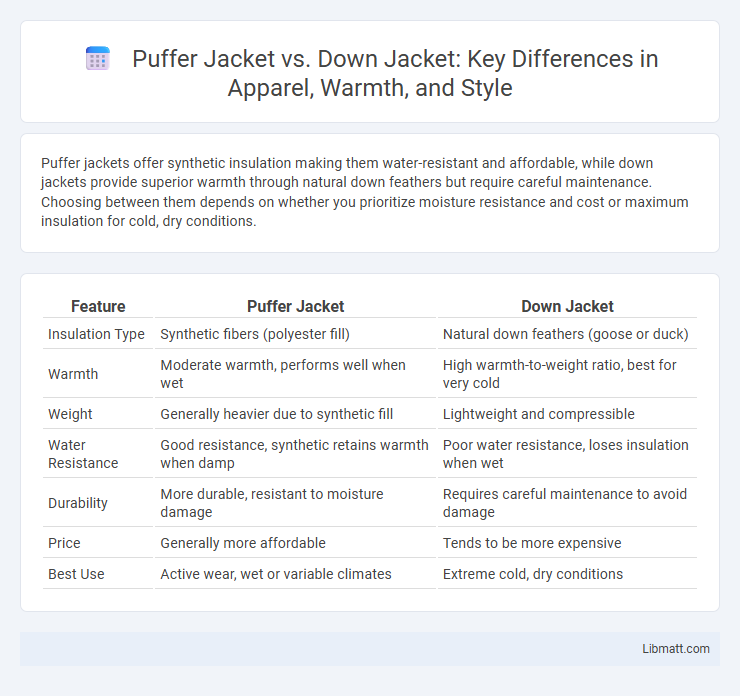Puffer jackets offer synthetic insulation making them water-resistant and affordable, while down jackets provide superior warmth through natural down feathers but require careful maintenance. Choosing between them depends on whether you prioritize moisture resistance and cost or maximum insulation for cold, dry conditions.
Table of Comparison
| Feature | Puffer Jacket | Down Jacket |
|---|---|---|
| Insulation Type | Synthetic fibers (polyester fill) | Natural down feathers (goose or duck) |
| Warmth | Moderate warmth, performs well when wet | High warmth-to-weight ratio, best for very cold |
| Weight | Generally heavier due to synthetic fill | Lightweight and compressible |
| Water Resistance | Good resistance, synthetic retains warmth when damp | Poor water resistance, loses insulation when wet |
| Durability | More durable, resistant to moisture damage | Requires careful maintenance to avoid damage |
| Price | Generally more affordable | Tends to be more expensive |
| Best Use | Active wear, wet or variable climates | Extreme cold, dry conditions |
Puffer Jacket vs Down Jacket: Key Differences
Puffer jackets are typically filled with synthetic insulation, offering excellent water resistance and affordability, while down jackets use natural goose or duck feathers, providing superior warmth-to-weight ratio and compressibility. The key difference lies in insulation materials, where down excels in lightweight insulation but performs poorly when wet, whereas puffer jackets maintain warmth in damp conditions due to hydrophobic synthetic fibers. Choosing between them depends on climate, activity level, and maintenance preferences, with down favored for dry, cold environments and puffers preferred for wet or variable weather.
What Is a Puffer Jacket?
A puffer jacket features a quilted design filled with synthetic fibers or down insulation, providing lightweight warmth by trapping heat within its stitched compartments. Unlike traditional down jackets, puffer jackets often use water-resistant outer shells and synthetic fill to offer better moisture management and easier maintenance. These jackets excel in cold weather conditions due to their excellent insulation-to-weight ratio, making them popular for outdoor activities and everyday wear.
What Is a Down Jacket?
A down jacket is insulated with the soft under feathers from ducks or geese, providing superior warmth-to-weight ratio compared to synthetic insulation found in puffer jackets. These jackets trap heat efficiently, making them ideal for extremely cold weather and outdoor activities. Your choice should consider the down fill power, which indicates insulation quality and overall warmth.
Insulation: Synthetic Fill vs Natural Down
Puffer jackets commonly use synthetic fill insulation, which offers water resistance, quick drying properties, and consistent warmth even in wet conditions, making it ideal for damp climates or active use. Down jackets utilize natural down feathers known for exceptional warmth-to-weight ratio and superior compressibility, providing lightweight insulation that traps body heat effectively in dry, cold environments. Your choice between synthetic fill and natural down insulation depends on climate, activity level, and maintenance preferences to maximize comfort and performance.
Warmth Comparison
Puffer jackets and down jackets both offer excellent warmth, but down jackets typically provide superior insulation due to their natural down fill, which traps heat more efficiently. Synthetic insulation in puffer jackets performs well in wet conditions, maintaining warmth even when damp, unlike down that loses its insulating properties when wet. Your choice depends on your climate needs, with down jackets ideal for dry, cold weather and puffer jackets better suited for wet or variable environments.
Weight and Packability
Puffer jackets typically feature synthetic insulation, making them lighter and easier to compress into small packs compared to heavier down jackets. Down jackets, filled with natural goose or duck feathers, offer superior warmth-to-weight ratios but can be bulkier when packed, especially if the loft is high. For ultralight travel or backpacking, puffer jackets provide better packability, whereas down jackets excel in colder conditions where warmth is paramount despite increased bulk.
Water Resistance and Weather Protection
Puffer jackets often feature synthetic insulation that maintains warmth even when wet, offering better water resistance compared to traditional down jackets, which can lose insulating properties if soaked. Down jackets excel in lightweight warmth and breathability but require a durable, water-repellent outer shell to provide adequate weather protection. Your choice should depend on the typical weather conditions you face, prioritizing water resistance for damp climates and thermal efficiency for cold, dry environments.
Durability and Care
Puffer jackets, often made with synthetic fibers, tend to offer greater durability and easier maintenance compared to down jackets, which require careful handling to preserve the natural insulation of down feathers. Down jackets need specialized cleaning methods, such as gentle washing and drying with tennis balls, to prevent clumping and loss of loft, while puffer jackets can typically withstand machine washing and rougher conditions without damage. When choosing between the two, consider your lifestyle and the level of care you're willing to invest to maintain your jacket's performance and longevity.
Price and Value for Money
Puffer jackets generally offer a more affordable price range compared to down jackets, making them an excellent choice for budget-conscious buyers seeking warmth. Down jackets, often priced higher due to premium natural insulation like goose or duck down, provide superior warmth-to-weight ratio and longer durability. Your decision should weigh upfront cost against long-term value, as investing in a quality down jacket can deliver better insulation efficiency and overall longevity.
Which Jacket Should You Choose?
Choose a down jacket for superior warmth and lightweight insulation, especially in extremely cold conditions due to its natural down feathers that trap heat efficiently. Opt for a puffer jacket if you need a versatile option that combines synthetic insulation with water resistance, making it ideal for wet or variable weather. Consider your activity level, climate, and maintenance preferences when deciding between these two popular cold-weather jackets.
Puffer jacket vs down jacket Infographic

 libmatt.com
libmatt.com